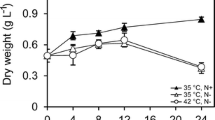Abstract
In the present paper we investigated the polyamine content and protein expression pattern in laboratory-reared Skeletonema costatum (Grev.) Cleve under temperature stress conditions. Putrescine, spermidine and to a lesser extent spermine were present in this alga. Free putrescine and spermidine increased after heat shock while a concomitant decrease in trichloroacetic acid (TCA)-soluble bound putrescine and spermidine occurred. After 40 min of 30 °C stress both were no longer detectable, whereas TCA-soluble bound spermine was present. The appearance of 83, 42, 40.7 and 35 kDa polypeptides was observed when S. costatum cells were subjected to heat treatment. Western blotting experiments revealed the presence in this diatom of ubiquitin and ubiquitin conjugates. Heat stress strongly increased the number of ubiquitin conjugate polypeptides of high molecular weight. No variation in the carbohydrate content was observed in response to stress. A possible role for these different metabolic events in the adaptive response of S. costatum to rapid temperature shifts has been hypothesized.
Similar content being viewed by others
References
Ang D, Liberek K, Skowyra D, Zylicz M, Georgopoulos C (1991) Biological role and regulation of the universally conserved heat shock proteins. J biol Chem 266:24233–24236
Bagni N, Torrigiani P (1992) Polyamines: a new class of growth substances. In: Karssen CM, van Loon L, Vreugdenhil D (eds) Progress in plant growth regulation. Kluwer Academic Publishers, The Netherlands, pp 264–275
Beers EP, Moreno TN, Callis J (1992) Subcellular localization of ubiquitin and ubiquitinated proteins in Arabidopsis thaliana. J biol Chem 267:15432–15439
Bonin DJ, Dropp MR, Maestrini SY, Bonin MC (1986) Physiological features of six macro-algae to be used as indicators of seawater quality. Cryptogam-Algol 7:23–83
Craig EA, Gross CA (1991) Is hsp 70 the cellular thermometer? Trends biochem Sciences 16:135–140
Dubois M, Gilles KA, Hamilton JK, Rebers PA, Smith F (1956) Colorimetric method of determination of sugars and related substances. Analyt Chem 18:350–356
Flores HE (1991) Changes in polyamine metabolism in response to abiotic stress. In: Slocum RD, Flores HE (eds) Biochemistry and physiology of polyamines in plants. CRC Press, Boca Raton, Florida, pp 213–228
Flores HE, Galston AW (1982) Polyamine and plant stress: activation of putrescine biosynthesis by osmotic shock. Science, NY 217:1259–1261
Galston AW (1989) Polyamines and plant response to stress. In: Bachrach U, Heimer YM (eds) The physiology of polyamines. CRC Press, Boca Raton, Florida, pp 99–106
Goff SA, Voelmy R, Goldberg AL (1988) Protein breakdown and heat-shock response. In: Rechsteiner M (ed) Ubiquitin. Plenum Press, New York, pp 207–238
Goldman JC, Ryther JH (1976) Temperature influenced species competition in mass cultures of marine phytoplankton. Biotechnol Bioengng 18:1125–1144
Guillard RRL, Ryther JH (1962) Studies on marine planktonic diatoms. I. Cyclotella nana Hustedt, and Detonula confervacea (Cleve) Gran. Can J Microbiol 8:229–239
Hamana K, Matsuzaki S (1982) Widespread occurrence of norspermidine and norspermine in eukaryotic algae. J Biochem 91:1321–1328
Kloppstech K, Ohad I (1986) Heat shock proteins synthesis in Chlamydomonas reinhardii. Eur J Biochem 154:63–68
Laemmli UK (1970) Cleavage of structural proteins during the assembly of the head of bacteriophage T4. Nature, Lond 227: 680–685
Lelong PP, Bianchi MA, Martin YP (1980) Dynamique des populations planctoniques et bacteriénnes au cours d'une production expérimentale de phytoplancton marin naturel. II. Structure et physiologie des populations et leurs interactions. Can J Microbiol 26:297–307
Le Rudulier D, Goas G (1975) Influence des ions ammonium et potassium sur l'accumulation de la putrescine chez le jeunes plantes de Soja ispida Moench priveés de leurs cotyledons. Physiol Veg 13:125–136
Magnani M, Stocchi V, Serafini G, Chiarantini L, Fornaini G (1988) Purification, properties and evidence for two subtypes of human placenta hexokinase type I. Arch Biochem Biophys 260: 388–399
McDonald RE, Kushad MM (1986) Accumulation of putrescine during chilling injury of fruits. Pl Physiol 82:324–326
Nagao RT, Kimpel JA, Vierling E, Key JL (1986) The heat shock response: a comparative analysis. In: Miflin BJ (ed) Oxford surveys of plant molecular and cell biology. Oxford Univ Press, Oxford, pp 384–438
Rodhouse PG, Roden C, Sommerville-Jacklin ME (1983) Nutritional value of micro-algal mass cultures to the oyster Ostrea edulis L. Aquaculture, Amsterdam 32:11–18
Schuber F (1989) Influence of polyamines on membrane functions. Biochem J 260:1–10
Serafini-Fracassini D, Dondini L, Del Duca S (1992) Meccanismi di adattamento metabolico allo stress osmotico in Dunaliella salina. G Bot Ital 126:347
Smith TA (1985) Polyamines. A Rev Pl Physiol 36:117–143
Smith TA, Best GR (1977) Polyamines in barley seedlings. Phytochem 16:841–843
Smith TA, Sinclair C (1967) The effect of acid feeding on amine formation in barley. Ann Bot 31:103–111
Tabor CW, Tabor H (1984) Polyamines. A Rev Biochem 53:749–790
Torrigiani P, Serafini-Fracassini D, Bagni N (1987) Polyamine biosynthesis and effect of dicyclohexylamine during the cell cycle of Helianthus tuberosous tuber. Pl Physiol 84:148–152
Towbin H, Stachelin T, Gordon J (1973) Electrophoretic transfer of proteins from polyacrylamide gels to nitrocellulose sheets: procedure and some applications. Proc natn Acad Sci USA. 76:4350–4354
Vårum KM, Myklestad S (1984) Effect of light, salinity and nutrient limitation on the production of β-1,3-D-glucan and exo-D-glucanase activity in Skeletonema costatum (Grev.) Cleve. J exp mar Biol Ecol 83:13–25
Vierling E (1991) The roles of heat shock proteins in plants. A Rev Pl Physiol Pl mol Biol 42:579–620
Vierstra RD, Langan SM, Haas AL (1985) Purification and initial characterization of ubiquitin from the higher plant, Avena sativa. J biol Chem 260:12015–12021
Wettern M, Parag HA, Pollmann L, Ohad I, Kulka RG (1990) Ubiquitin in Chlamydomonas reinhardii. Eur J Biochem 191:571–576
Young ND, Galston AW (1983) Putrescine and acid stress. Pl Physiol 71:767–771
Author information
Authors and Affiliations
Additional information
Communicated by M. Sarà, Genova
Rights and permissions
About this article
Cite this article
Scoccianti, V., Penna, A., Penna, N. et al. Effect of heat stress on polyamine content and protein pattern in Skeletonema costatum . Marine Biology 121, 549–554 (1995). https://doi.org/10.1007/BF00349465
Received:
Accepted:
Issue Date:
DOI: https://doi.org/10.1007/BF00349465




